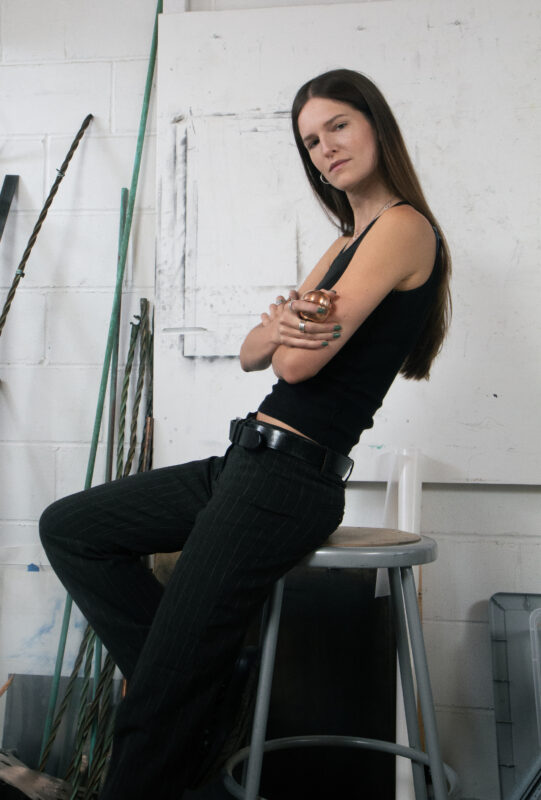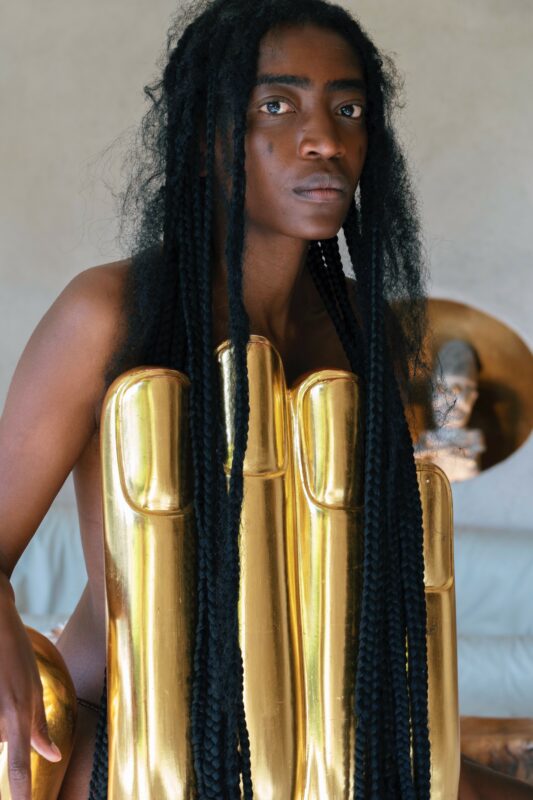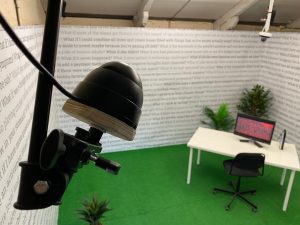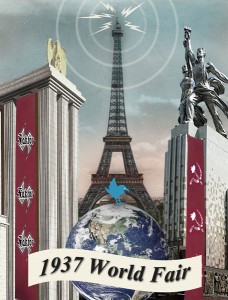 Image courtesy Broughton & Birnie and WW gallery, 2013.
Image courtesy Broughton & Birnie and WW gallery, 2013.
By Yvette Greslé
Sluice Art Fair was launched in 2011 by Karl England and Ben Street. Every autumn, in London, there is an overwhelming proliferation of art fairs in the week dominated by the formidable Frieze. Sluice, which is artist and curator led, offers a welcoming counterpoint to the shopping mall sensations of Regent’s Park. It’s a fascinating insight into artist and curator led projects and initiatives that explore art-making, survival and ways of being outside of a rigidly overly prescribed art market. This year Sluice occupies a three-story Victorian warehouse a few minutes walk from Bermondsey Street and Tower Bridge. England and Street have facilitated an experience that is inviting, warm and wonderfully social. This is an excellent opportunity for collectors, both young and established, to meet artists and curators, and learn about grassroots artists initiatives, from the UK, Europe and the USA. Work is also affordable for those who wish to begin art collections within the parameters of limited budgets. And the fair itself is free. There is beautiful drawing, painting and object-based work alongside installation, video and performance from artists such as Paul Kindersley. The programme also includes a series of talks and discussions including some comic relief with artist and writer Alistair Gentry and Artbollocks Theatre. Live streamed on Saturday afternoon, it includes dramatic readings of the worst gallery press releases, the most comically bad artists statements and the most incomprehensible critical writing about art www.gentry-a.co.uk.
Karl England is also a practicing artist (selected for Reside Residency, Morph Plinth) and Ben Street lectures at Tate, the National Gallery and the Saatchi Gallery. He also writes for Art Review.
The fair takes place Saturday 19 October and Sunday 20 October 2013 (12 noon-9pm). Nearest tube: London Bridge. For more information and related events: www.sluiceartfair.com.
What is Sluice all about?
Karl England: It’s a lot more vibrant than a general art fair. We use a particular format: there are no booths and there are no public gangways, there are no delineated spaces. It’s almost like a jumble sale of artist-run projects. It forms one big artwork in a way, over three floors. The exhibitors don’t occupy a space that’s like an island on its own with walls, separated off from the others. There’s communication across exhibitions. This is what artist-run spaces are about. It’s about artists networking and talking and sharing, finding out about other artist-run spaces and showing in those. What’s exciting about this year’s fair is that we have exhibitors from all over the UK (a lot of them don’t know each other) and we’ve also got five from New York. The network can really grow. There are different kinds of artist and curator run spaces, some work as a gallery and travel to art fairs both in the UK and internationally. But then there are others who would never dream of being in an art fair but do it because they don’t view it as an art fair.
Ben Street: All of the 37 spaces involved in Sluice operate in a completely artist-centred way. There are spaces run by artists and others run by curators. You’re seeing practice by artists, curated by artists, selected by artists, totally artist-centric. The atmosphere of Sluice is relaxed and open plan, no booths, so you get a cross-pollination of ideas and of images. We also have live programming that happens all the time. There are performances happening through the weekend. There is also education programming and children’s art workshops. I work for museums in London doing education programs and have done for many years. I’m running a children’s art workshop which is a response to the art in the fair. I’m doing a conceptual education performance event, with the artist Sarah Hutchinson. On Sunday there’s a discussion with five gallerists from the Bushwick scene in Brooklyn. I used to work in the States, and museums in America. They have a really fantastic, fascinating, grass-roots artist-led scene.
 Emily Hesse of Class I Project Space in front of ‘Dark Horses’. Courtesy Emily Hesse.
Emily Hesse of Class I Project Space in front of ‘Dark Horses’. Courtesy Emily Hesse.
Class I Project Space, which opened in March 2013, is based in the North Eastern town of Saltburn-by-the-Sea. Their aim is to build communities of artists and those who encounter art and are affected by art. Class I is managed by artist-in-residence Emily Hesse www.class1gallery.com
Emily Hesse: We’re an open space: We like people to approach us to do work. Often we find artists who have shoebox type studios who don’t get opportunities. We’re not a funded space. We barter and exchange, so if we work with an artist we expect something back in exchange. They can give in time, a lecture, a talk. The work you’ve asked me about, ‘Dark Horses’, is literally a metal structure that is a Grade 2 listed shoebox from a building where the gallery is situated (a Grade 2 listed school). The object you see here was found discarded even though it’s in the original listing in the original documents. In order to make the work in it which is a sculpture/installation I had to apply for planning consent which is documented. The work is about being the underdog, the one that comes from nowhere. It’s a silent protest against rules and systems, boundaries and constraints. The work is actually invisible it doesn’t show up on any of the documentation. It’s made from invisible nylon. People are going to have a hard time seeing it, and we’ll see what people make of it.
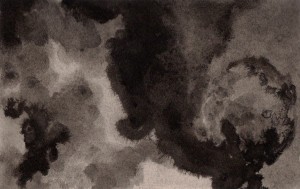 Richard Ducker, ‘Dark Matter’, 2012, ink on paper. Copywright Richard Ducker. Courtesy Dalla Rosa Gallery.
Richard Ducker, ‘Dark Matter’, 2012, ink on paper. Copywright Richard Ducker. Courtesy Dalla Rosa Gallery.
Dalla Rosa Gallery, Clerkenwell, London www.dallarosagallery.com
Phillip John Jones: I work for Dalla Rosa, based in Clerkenwell (the gallery is directed by Giovanna Paternó). Even though we have a broad range of artists we mainly focus on works on paper. This can be anything from traditional drawings and prints to Kasper Pincis who’s been doing drawings onto surfaces which he’s made himself out of balsa wood and gesso. We’ve recently started working with Catrin Morgan, an RCA graduate. She’s just worked with Granta Books, illustrating ‘The Age of Wire and String’ by Ben Marcus. She’s also showing at the moment in the Jerwood Drawing Prize. Richard Ducker is a curator as well as an artist who normally works with sculpture. His drawings, here at Sluice, are very dark, a bit like Goya, they’re a series of explosions. He’s filtered images from the news over the years and then he does an ink and paper drawing, of what look like these explosions, a dark cloud, the aftermath, the effect of an explosion. When we exhibited them we had over 100 on display in a row round the gallery on a gray background and the effect was quite overwhelming. Jeremy Evans who just did a performance here at Sluice today is essentially a performance artist although he does do works on paper. He wrote a script, a play, almost literature. His performance is about reading out a letter, a monologue based on a mythology of writing, ideas of writing, and how we set rules.
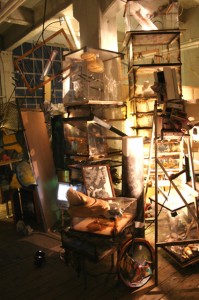 David Miller, Ian Andrews and Paul Newman, ‘Babelling’ in progress at Terrace, Birmingham. Courtesy Terrace.
David Miller, Ian Andrews and Paul Newman, ‘Babelling’ in progress at Terrace, Birmingham. Courtesy Terrace.
Terrace is an artist run gallery based in The Great Western Arcade, Birmingham. Curator and artist David Miller collaborates with artists Ian Andrews and Paul Newman on ‘Babeling’ www.terracegallery.org.uk
Ian Andrews: The Great Western Arcade is a Victorian shop front. David Miller runs the gallery, and Paul Newman and I were invited to show there. We recognised similarities in the way that we work, although visually our work looks very different from one another. But we share a similar methodology, and so we started to link up. Paul and I did a tentative collaboration at the ITV building in Birmingham as part of a show called ‘Going Postal’ and then Dave wrote the proposal for Sluice called Babeling: it’s a work based on the Tower of Babel. God decided that Man, because of building this tower going heavenwards, should be punished by being made to speak lots of different languages instead of one. So no-one would be able to communicate or cooperate ever again. We thought this was an interesting metaphor for the state of modern art, we all have a different language, and there’s no clear tradition. Yet we think we can connect and communicate despite the lack of shared tradition. This is what this work is about as well as our individual, personal practices, and the individuality that we bring to our pieces. David Miller made the photographic and very well-made, beautiful cabinets that you peer into to see see films showing inside them. Paul Newman made the films and the brightly coloured paintings and structures where they look as though they’re growing out of paintings, the detritus of the painting process, 2D becoming 3D. My work is where they tend to look as though they’ve been around for 50 years, worn down, and under serious threat of collapse. My work is about memory and forgetting.
 Corinna Spencer. ‘Fleeting Obsession 4’, 2013, Oil on paper. Courtesy Transition Gallery.
Corinna Spencer. ‘Fleeting Obsession 4’, 2013, Oil on paper. Courtesy Transition Gallery.
Transition, in East London, is an independent gallery and publisher founded by artist Cathy Lomax in 2002. Among Transition’s publications is the arts and culture magazine ‘Garageland’ www.transitiongallery.co.uk
Cathy Lomax: For Sluice we made a curated project. We’ve got 11 artists showing here. It’s called ‘The Dream Machine’ and the theme is Hollywood black and white cinema especially silent cinema. We’re thinking about the way that silent and black and white cinema is making a reappearance. There was the film ‘The Artist’, and there are other films recently which seem to be nostalgic and retrospective in how it is they look back at older times. But at the same time they’re very modern. The biggest piece which is right here in the centre of the room is by Charlotte Squire. She’s made a light piece with an amazing black and white chequerboard floor. All the Transition staff are also dressed in black and white especially. I love a strong theme both for ‘Garageland’ and shows. I get really excited about these themes and the subjects we explore. My work for the show draws on film posters. Corinna Spencer’s paintings are empty lockets. She was thinking about the fickle nature of fandom, where a fan will love one Hollywood star and then another and so on. So she played with this idea of an empty locket. In my work, I’m thinking more about the names that Hollywood stars were given, like the ‘Love Goddess’. Their identity would be taken away and they’d be re-branded and transformed into this amazing creature which isn’t like real life at all. Consequently, they all would be quite unhappy in their personal lives. That idea of fandom and unattainable glamour is something we’re quite interested in at Transition.
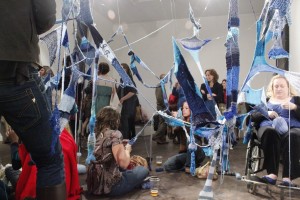 Sarah Filmer, an earlier version of ‘The Blue Jumper’, a collaborative art/research/knitting project. Courtesy Sarah Filmer.
Sarah Filmer, an earlier version of ‘The Blue Jumper’, a collaborative art/research/knitting project. Courtesy Sarah Filmer.
Helen Marland, Celest Ingrams and Sarah Filmer are from Unit 11 Studios, an artist lead space in Southhampton www.unit11studios.wordpress.com
Celest Ingrams: We support individual practice as well as working collectively, participating in group and community engagement projects. My practice is drawing based: I look a lot at language. My work is about trying to comprehend experience and relationships. I’m doing some drawings at Sluice, paying attention to details, as a way of processing experience and observation in a visual form. I mainly do paper work and have explored the actual making of paper as part of my practice.
Helen Marland: I make photographs that think about the built spaces that we live in. I’m quite interested in the effects that they have on us. I couple this with the fact that the photograph is two dimensions, and the photograph can also deceive. I play with these ideas about deception which isn’t necessarily a bad thing. I think a lot about how to present the work which is often translated onto the walls of buildings. I like this idea of not really having an object. Often my work is site-specific. What I like about the work for Sluice is the way it plays with light coming through the window, and you don’t know whether the light and shadows cast are part of the photograph or not.
Sarah Filmer: This work is about the spaces you inhabit with other people, and being in a space. You can’t knit remotely and then add your piece to it. You have to be physically in the space with the thing in order to do the knitting. That’s the rule. The other one is that it should be blue but a few people have subverted that with other colours. It’s about being in a space physically with someone: it’s about connection, relationships, community and participation. The thing that’s astonished me about this piece is how generous people are with their time and skills. People really want to give to it. My practice ordinarily is video: I work with digital video. It’s all about pixels. In this work I like to think of each stitch as the equivalent of a pixel.
 Broughton & Birnie, From ‘BERLIN: The Forager’s Tale’, 2013. Courtesy WW Gallery and the artists.
Broughton & Birnie, From ‘BERLIN: The Forager’s Tale’, 2013. Courtesy WW Gallery and the artists.
WW gallery, Clerkenwell, London present the artist duo Broughton & Birnie. WW was established in 2008 by the artists Debra Wilson and Chiara Williams. Among other things the gallery run a very popular Surgery for artists www.wilsonwilliamsgallery.com
Fiona Birnie: ‘The Forger’s Tale’ is based on a character we named Georg Bruni. We presented this work at the Crypt Gallery in May 2012 which is where Debra Wilson and Chiara Williams found us. We then had a show at WW gallery called ‘The Forger’s tale: The Quest for Fame & Fortune at WW earlier this year.
Kevin Broughton: We wanted to make an alternative reality where you follow the story, and understand things, even though you know it’s not factually correct. It’s how you interact on the Internet, there’s so much information and everything’s going in so many different directions. You have to make your own decisions. That’s what’s interesting about what we’re trying to do. We’re trying to make something that gives you a lot of possibilities and directions. But the work doesn’t give you a clearly defined view. Georg Bruni exists in a period where we found the art interesting. When I actually looked up the name on the Internet, I found people with this name. Some of the work draws on forgers we knew about. Some things are to do with films that we’ve seen. Everything is pulled together. We wanted to have something based on truth that was both possible and plausible (to a certain extent) but at the same time totally improbable.
Fiona Birnie: The way we work does draw on practices such as Dada, and on how artists explored modern technology and the hand-made processes of collage. We also grew up with Punk, which was very much a ‘make it yourself’ era. I do a lot of photo restoration and have a huge collection of photographs. Photography is always seen as a factual piece of evidence. We use a lot of photographic material that people aren’t familiar with. For the Forger work we used Johnny Depp because there’s the most amount of material on the Internet on him but people didn’t know it was him.
Kevin Broughton: It’s interesting to think about what happens when you take away from what somebody expects, Johnny Depp is an actor, you expect him to be in a film. But if you put him into a story, that’s set in another historical time, people don’t see him anymore. He becomes somebody totally different. A lot of our stuff is made using the Internet, printed off it, and then added to by hand.
Fiona Birnie: You can’t view something from history without what you know now. But I don’t think you can ever get away from history. We’re also interested in what’s going on politically now. Satire is part of the work. A lot of the artists we like are dealing with political satire. The interesting thing with history is finding the links. It’s like being an investigator. We explore figures across history and the present. People from popular culture like Jedward have become such icons because of technology, and the Internet, whether you like it or not.
Kevin Broughton: The density and multi-layering of the work and our installations is driven by the Internet. If you look for an image through a search engine you get a vast amount of material, but it’s not necessarily what you might have expected. Information and images are constantly in front of us and around us. It’s all-encompassing and prolific. We don’t ever switch off. When things are presented in a very logical, simplified timeline it feels really alien now. We’re very interested in how people interact with stuff in the same way that the Internet is experienced, as something all around us. Art doesn’t really exist without the audience living in it.
Sluice Art Fair 2013, takes place Saturday 19 October and Sunday 20 October 2013 (12 noon-9pm). Nearest tube: London Bridge. For more information and related events: www.sluiceartfair.com.
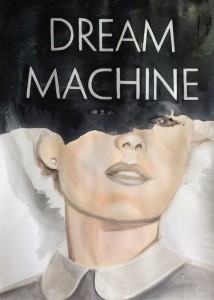 Cathy Lomax, From ‘The Dream Machine’, Transition Gallery at Sluice 2013. Courtesy Cathy Lomax.
Cathy Lomax, From ‘The Dream Machine’, Transition Gallery at Sluice 2013. Courtesy Cathy Lomax.
Categories
Tags
- Art Fairs
- Art Interviews
- Ben Marcus
- Ben Street
- Broughton & Birnie
- Cathy Lomax
- Catrin Morgan
- Celest Ingrams
- Charlotte Squire
- Class 1 Project Space
- Corinna Spencer
- Dalla Rosa Gallery
- David Miller
- Emily Hesse
- Helen Marland
- Ian Andrews
- Jeremy Evans
- Karl England
- Paul Kindersley
- Paul Newman
- RICHARD DUCKER
- Sarah Filmer
- Sarah Hutchinson
- Sluice Art Fair
- Sluice art fair 2013
- Terrace
- transition gallery
- WW Gallery

